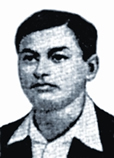Basu, Benoy Krishna
Basu, Benoy Krishna (1908-1930) a revolutionary of the Yugantar group, was born in a middle class Kayastha family in the village of Rohitbhog (variants, Routhbhog, Raitbhog) in the Munshiganj district on 11 September 1908 and was the son of Rebatimohan Basu, an engineer, and Kshirodabashini Debi, a deeply religious lady

Benoy received his early education in Dhaka and joined the Mitford Medical School (now Sir Salimullah Medical College) after passing the Matriculation Examination. In his youth he came under the influence of Hemchandra Ghosh, a well-known revolutionary of Dhaka and had joined the ‘Mukti Sangha’, a secret society that was closely connected with the Yugantar Party. Because of his revolutionary activities he could not complete his medical education.
After the First World War, Hemchandra shifted his activities to Calcutta and remained closely attached to this group. In 1928, at the Calcutta Session of the Indian National Congress when subhas chandra bose organised a group named Bengal Volunteers under the leadership of Major Satya Gupta, with himself as GOC Benoy and his fellow revolutionaries owing allegiance to the Benu group joined the new organisation. Soon he became influential in the group and established a local unit of the Bengal Volunteers in Dhaka. Within a short period the Bengal Volunteers transformed itself into an active revolutionary organisation and decided to launch 'operation freedom' in early 1930s. The Bengal Volunteers in Dhaka took such a stand primarily to voice their protest against the police repression in different jails in Bengal.
Benoy, then a medical student, was called upon to strike the first blow. In August 1930, Benoy came to know that Lowman, the Inspector General of Police, would be visiting the Medical School Hospital to see an ailing senior police official undergoing treatment. On 29 August 1930, Benoy casually clad in traditional Bengali attire, breached the security and fired at close range. Lowman died instantly and Hodson, the Superintendent of police, was grievously injured. Benoy evaded arrest and escaped to a party shelter in Calcutta. The police began a manhunt and announced prize money of Rs 5000 on Benoy's head. At this time Subhas Bose was anxious to send him abroad, but Benoy boldly refused.
However, within a few months Benoy and his group was into action again. The Inspector General of Prisons, Col NS Simpson had become an eyesore of the revolutionaries for unleashing a brutal oppression on the prisoners in the jails. The revolutionaries decided not only to liquidate him, but also to strike a terror in the British official circles by launching an attack on the Secretariat Building. On 8 December 1930, Benoy along with dinesh chandra gupta and badal gupta, dressed in European costume, entered the Writers' Building and shot dead Simpson. Some other officers like Twynam, Prentice and Nelson, known for their terror tactics, also suffered injuries during the shooting.
Despite being successful in their venture Benoy and his fellow revolutionaries, however, could not escape. The police contingent under the command of the Inspector General and the Police Commissioner opened fire on them. The young revolutionaries continued the unequal fight for sometime. Determined not to give themselves up to the police Badal swallowed Potassium Cyanide, while Benoy and Dinesh shot themselves with their own revolvers. Badal died instantly. Benoy succumbed to his injuries on 13 December 1930. Dinesh who recovered in the hospital, was tried and sentenced to death. Thus, Benoy and his fellow revolutionaries became martyrs and their sense of dedication and self-sacrifice became objects of emulation for the future generations in Bengal. [Raj Sekhar Basu]
Bibliography Hemendranath Dasgupta, Bharater Biplab Kahini, II and III, Calcutta, 1948; RC Mazumder, History of the Freedom Movement in India, III, Calcutta 1963; Ganganarayan Chandra, Abismaraniya, Calcutta, 1966.
